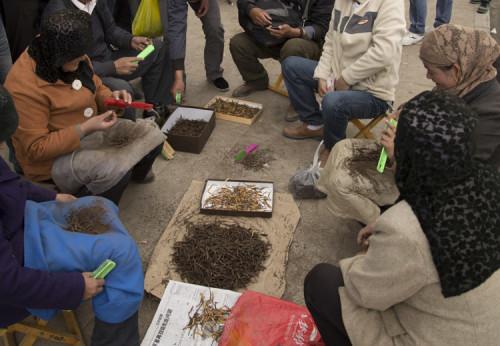From the windswept traces of ancient trade routes to thriving modern marketplaces, the story of commerce in Tibet is a fascinating one. Joanna James finds out more…

Even with modern transport and infrastructure, a journey in Tibet quickly assumes the air of an adventure. Consider then the challenges and perils of a journey to Lhasa in, say, the 1860s or 1920s. The journey would take many weeks. You would have to contend with high altitude, bandits, extreme temperatures, changeable weather and long, long stretches of tough and waterless terrain. Think for a moment – what could induce you to undertake such a journey?
As I researched our story The Longest Relay last year, the thing that most impressed me was that anyone ever set out on these epic journeys. And yet, while Tibet might live in our imaginations as an isolated mountain fortress, in reality it was connected to its neighbours by a web of well-trodden trading routes.
Salt and wool were trekked out from the wastes of the Tibetan Changtang and exchanged for grain in Kathmandu’s bazaars. Tea from Yunnan and Sichuan was transported to Lhasa and traded for skins, musk and gold dust. Cloth and ceramics were imported from the Chinese lowlands and exchanged for exotic traditional remedies.



Caterpillar fungus is half plant and half animal – yartsa gunbu translates literally as “winter worm, summer grass”; a parasitic fungus that grows from the body of the ghost moth larvae. Found only at altitudes above 4000m and gathered by hand, the fungus has been used in Tibetan and Chinese remedies since the 15th century.
As the use of caterpillar fungus has become a status symbol elsewhere, it has also become an important source of income to communities across the Tibetan Plateau. Early each summer, you can see hillsides dotted with people bent double, poring over the grasslands for signs of yartsa gunbu, and impromptu markets like Hezuo’s spring up in towns across the plateau.
The flourishing caterpillar fungus trade has also reached the Muslim Quarter of Lhasa’s Old Town, although the bulk of the city’s commerce goes on elsewhere in its narrow streets. An alleyway near the Jokhang Temple is filled with stalls selling juniper branches (thrown into the temple’s pot-bellied incense burners) and yak butter (for fuelling butter lamps). Hundreds of everyday items – vegetables, blenders for yak butter tea, and mala prayer beads – are bought and sold nearby in Tromsikhang Market.
Regardless of how romantic these trade routes and markets may seem to outsiders, Tibet’s modern-day merchants and traders’ greatest similarity to their fore-runners is in their pragmatism. If there are willing buyers, willing sellers will find a way to meet their needs – no matter how great the distances or challenges attendant in doing so. The face of trade here may look different, but its heart beats the same rhythm as ever.

